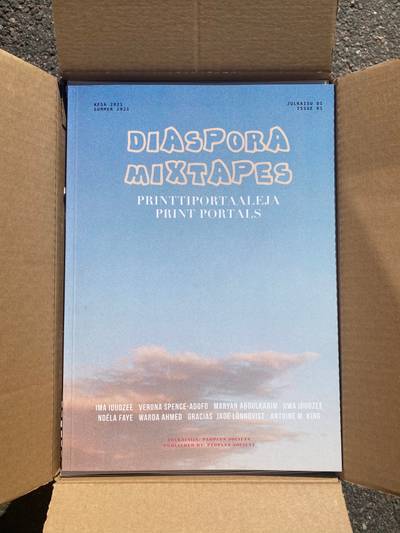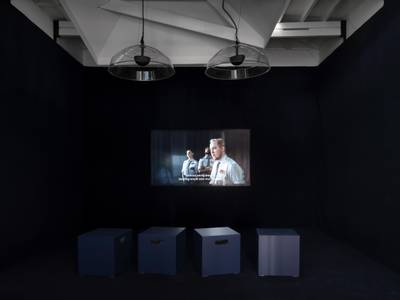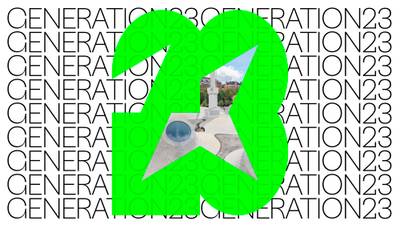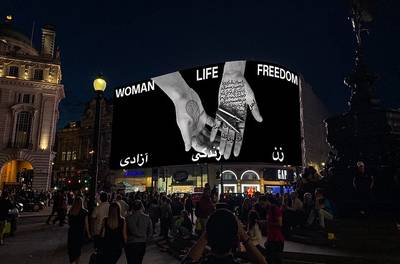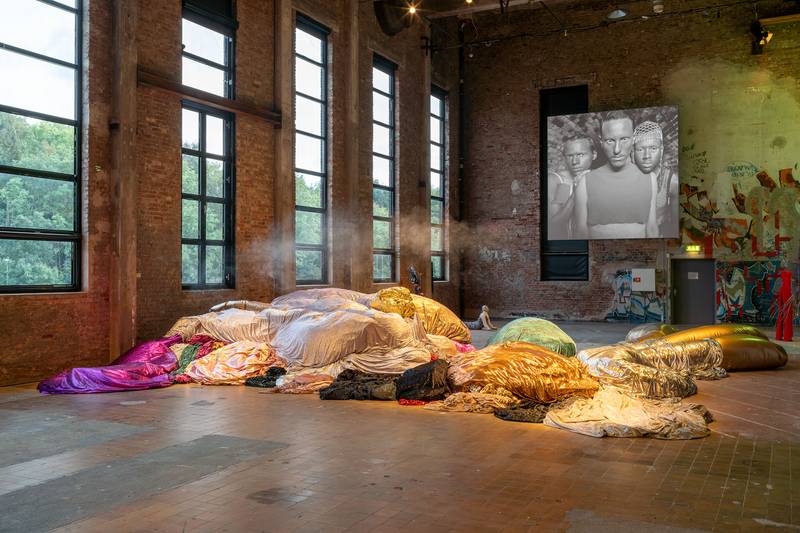

Installation view, Röda Sten Konsthall. Maria Jerez: Yabba (2017 / 2023); Luiz Roque: S (2017). Photographer: Hendrik Zeitler
Eero Karjalainen is a critic and art historian based in Helsinki. In his writing Karjalainen has focused on topics such as the ecologies of art history, museum collections, criticism as collectivity, and contemporary painting. Karjalainen has also initiated exhibitions in Finland and internationally.
Contextual universality
When an exhibition that is firmly linked to a specific geographical context takes a multifold form both concretely (multiple sites are activated) and discursively (a vast cycle of performances and off-program happenings), possible observations made by the visitors can quickly turn from specific details to a broader perspective: the context itself. This is not unusual for international contemporary art exhibitions, where it is more of a rule than an exception that it is not possible to see every performance, attend every talk, and visit every materially changing work of art multiple times. When attuning to the context over detail, the relationship—whether apparent or foggy—between concept and site becomes more apparent.
Göteborg International Biennial for Contemporary Art (better known as GIBCA) is one of the oldest biennials for contemporary art in the Nordic countries, and it usually presents artists from the Nordic region. This is also somewhat true of this year’s iteration, curated by João Laia. However, there are also multiple artists who don’t come from the contemporary art field of the north, which places this year’s exhibition in a more global context. This is not to say that this year’s GIBCA is an example of a post-globalized exhibition, where different localities are presented in motivation to represent geographical diversity, but rather as a note of the exhibition as something that does not take its institution—the biennial—as a starting point.1 For instance, this year’s exhibition is more present in the city’s here and now but also—and perhaps more importantly—of the possibilities of the exhibition as a form of presenting ideas of being together when compared to the last two editions of GIBCA, both of which took the history of Gothenburg as a starting point for a narratological critique of the city and its institutions. Coming or being together is presented as an idea and is thus a universal idea, while more focus is shed on the importance of introducing some futurity. One, which can lead to others.
An exhibition’s positions
During and after my visit to the 12th edition of GIBCA, forms of the surrounding futures, I’ve been asking myself: from which position do I look at this place as a site for an exhibition? Questions regarding one’s position when participating in discourses of art criticism are—or should be—always at the centre of the writing or augmenting subject, but when writing with GIBCA, they seem to be prominently present. There are two strands of artistic operations, which are in constant tension, present in the exhibition that lead me to this argument. First, the relationship between the works of art and the context, and second, the universality of the exhibition as a whole.
The exhibition is divided into three instances: the concrete, static exhibitionary parts, a performance programme, and a selection of video works available on the website of the exhibition. There are four locations that present a group of artists. The main location of the exhibition is, as is typical in the history of the biennial, the Röda Sten Konsthall, which is also one of the main contemporary art institutions in the city. There is also a group of artists presented at the Göteborgs Konsthall and two smaller occurrences in the city library, close to the latter kunsthalle, and at Hammarkullen Konsthall, which is located in the Hammarkullen metro station. The performance programme presented seven durational works of art during the opening weekend of GIBCA, and the collection of videos, titled forms of the surrounding futures: screening, shows videos from five artists seen in the exhibition on the biennial’s website.2
The conceptual framework of the exhibition leans on the act of mapping out (potential) futures through implementing a rather in flux definition of queerness as a method for operating.3 The title, forms of the surrounding futures, presents the concept, but it would actually suit better, I think, to speak about a kind of labile conceptual disposition rather than a fixed concept, for the exhibition does not present a concept that could be drawn out clearly. This is also seen in the curatorial essay in the exhibition guide, which leans heavily on timely thinkers of the queer, such as José Esteban Munoz, Paul B. Preciado, and Sarah Enson. The essay by Laia presents a collection of thinkers rather than a cohesive argument, which could be transported to and pointed out in the exhibition itself.4
Overlapping concepts
The fluidity and unclear nature of the conceptual starting point is deliberate, and as aesthetics of an exhibition, it works. At the same time, I am left thinking about the argument(s) the exhibition serves. An exhibition architecture in flux, such as in this year’s GIBCA allows for overlapping and contradictory arguments that are present at the same time in the same room. For example, in the main exhibition hall on the second floor at Röda Sten, an installation in the centre of the room consisting of huge colourful breathing pillows under which smoke emerges at times called Yabba (2017/2023) by Maria Jerez meets a superb video work titled S (2017) by Luiz Roque, hung high up on the wall. The seemingly soft shapes of Jerez’s installation call to slow down and breathe while thinking about the transformative writings of activist and artist Jota Mombaça, on which Roque’s video is based. The same kind of crossing of materiality and queer speculation is present in the textile-based works of Esse McChesney in the same venue. Adapting the techniques of weaving and embroidery, the artist presents a beautiful series of works in which the visual representations of different species, trans bodies, and contexts collide. McChesneys work’s are among the best and most thought-provoking in the exhibition.
The material situation in both rooms presents a calmness that is constantly interrupted by the contiguous queer narratives, where a history of oppressive violence and means of radical care live side by side. Speculation as a modus operandi is important when dreaming of a future that builds on coexistence. Coexistence requires collective unlearning, also regarding, but not limited to, more-than-human species and other oppressed voices. Which voices are heard here?
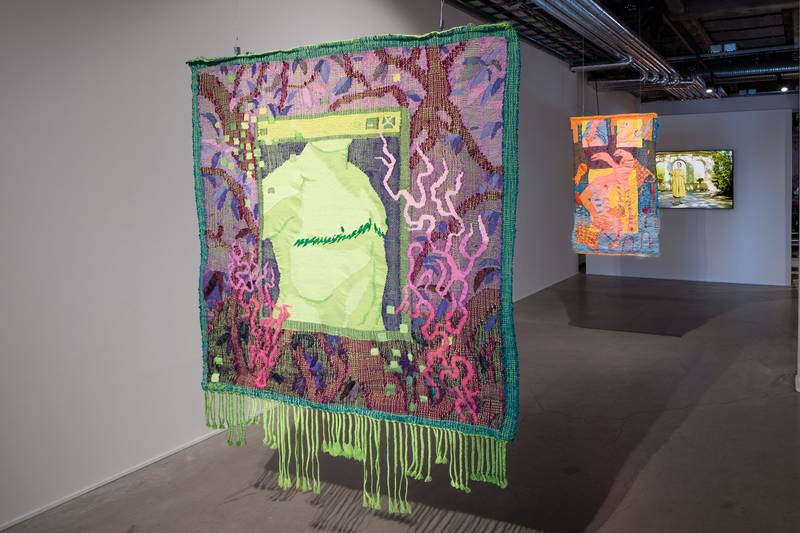

Esse McChesney: Längtan/oro (2022). Photographer: Hendrik Zeitler
More often than not, I find myself not looking for the wall texts in any of the exhibition venues or reading the artwork descriptions in the guide. Whether at the Röda Sten, which presents the majority of the works, or at the City Library, where only two artists are shown (and where I can’t find any texts, even with the help of the staff), the same vignette of unclear relations between the exhibition and the site of the exhibition guides my movement. The exhibition works as a site of reflection itself, not as a comment on its physical location, like many of the last editions of the biennial. A good example can be found in Göteborgs Konsthall, where only a few works are installed. The first and largest room in the Kunsthalle presents only three artists: Outi Pieski, Ana Vaz, and Guadalupe Maravilla. Sitting, sensing, and thinking in the room, it forms a generous space for reflection. The same experience presents itself in the city library, where Adam Christensen’s textile drapes series How is Your World (2023), hanging from the ceiling and reaching whole the height of the building, and Agnė Jokšė’s video work Dear Friend from 2019, installed against a window, make me look past them, focusing my gaze on the city and its (infra)structures. This is linked also to the experience of the space: the traditional idea of a library as a quiet site for study is broken even on a Sunday morning: people are talking with each other or speaking on the phone, listening to music without headphones; I don’t visit the library often since I don’t live in the city, but I believe the notion that the library really is a site of collective coming together. The way that the exhibition is spacious but also in the way that it presents thinking to the visitor feels light when compared to, for example, another Nordic biennial this year, the Helsinki biennial.
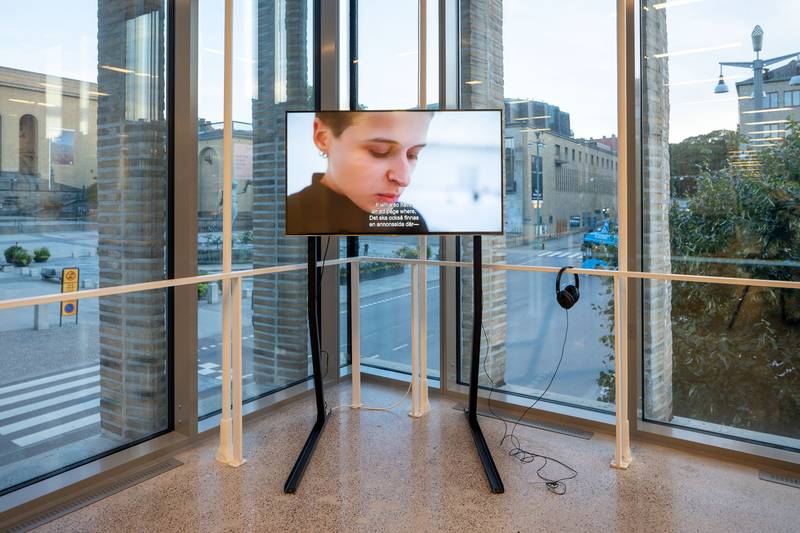

Agnė Jokšė: Dear Friend (2019). Gothenburg City Library. Photographer: Hendrik Zeitler
In addition, the small number of publications without much theory allows for something else than a discursive experience, further emphasising the feeling of lightness. There is the small, pocket-sized exhibition guide without pictures, where the artists are presented with a few sentences. A magazine distributed around the city of Gothenburg and available only in Swedish, as explained by a representative of the exhibition at Röda Sten Konsthall, is targeted at the residents of Gothenburg. It is not, I think, that odd that an international exhibition only publishes some material in its mother tongue; it’s odd that the organization would think that all the people living in Gothenburg speak Swedish.
Abridged performativity
Even though it is clear that it is extremely difficult and usually impossible—but also hardly necessary—to see everything happening related to an exhibition, in the case of this year’s GIBCA, I am disappointed that the performance programme in full only took place once, during the opening weekend. The programme, titled a calling, a celebration, was divided into two parts: a daytime (a calling) and a night-time (a celebration), reminding me of the 5th Berlin Biennale, curated by Elena Filipovic and Adam Szymczyk, where the nighttime was activated to destabilise the idea of the exhibition as something where knowledge production has stopped. For me, the performance programme was not the starting point of the exhibition but a key factor in concretely proposing spaces for collectivity. Something that could happen every day and night.5
Ania Nowak’s performance To the Aching Parts (Manifesto) (2020), which took place on the stairs of the Gothenburg Museum of Art, spread as an echo for questioning the language we use when we speak about the queer subject: Nowak’s performance reminds us that the queer body has a violent history but is also present. A documentation of Nowak’s performance is also present at Röda Sten, where the nighttime part of the performances happened. The group of performances was spread across the venue, which was activated in numerous ways. Rasmus Myrup’s installation Outside Salon des Refusés (2023) came to life in Myrup’s joyful performance Je te vous présente, where the installation, consisting of 23 figures emerging from Scandinavian folklore and Norse mythology, becomes a collective of clubbers entering a club. Niko Hallikainen continued his work with performance poetry, where the artist brings great amounts of text over the audience by reading into a microphone, describing and criticising building projects in Gothenburg and the institution—Roda Sten, the artists, the visitors—and breathing into the microphone: “Welcome to the biennial of your dreams.” The irony in Hallikainen’s performance is deliberate and solemn, but I am left thinking: whose dreams are projected here? The universality in the forms of the surrounding futures comes with unanswered questions regarding the space it creates and tries to create.
Continuing on the lines of Hallikainen and thinking about the space and place where we were, the collective KEM produced a nightclub called Dragana Bar in Röda Sten, which itself has previously been a nightclub. Through activating different histories and presenting alongside them new potential moments, a subtle dialogue between the place and the act of people coming together capsulizes the basic character of the exhibition. Does this happen when the performances are not present? Visiting the exhibition after the performances are gone, it sure seems that something is missing.
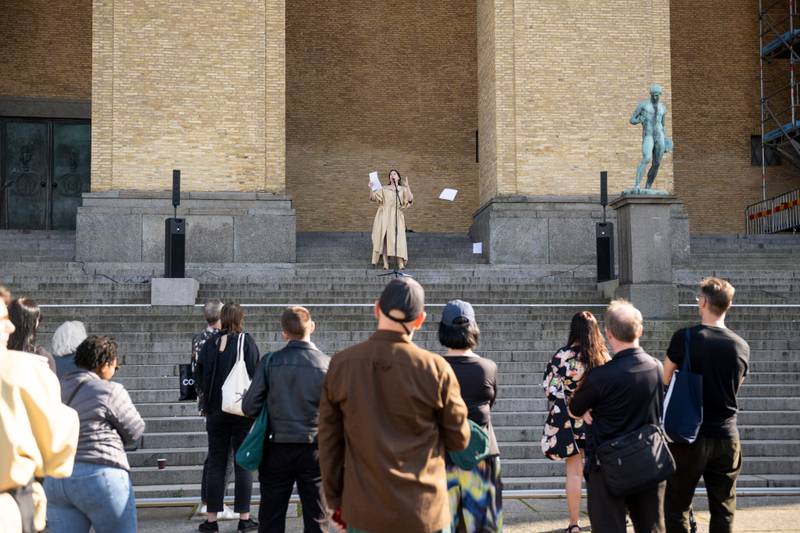

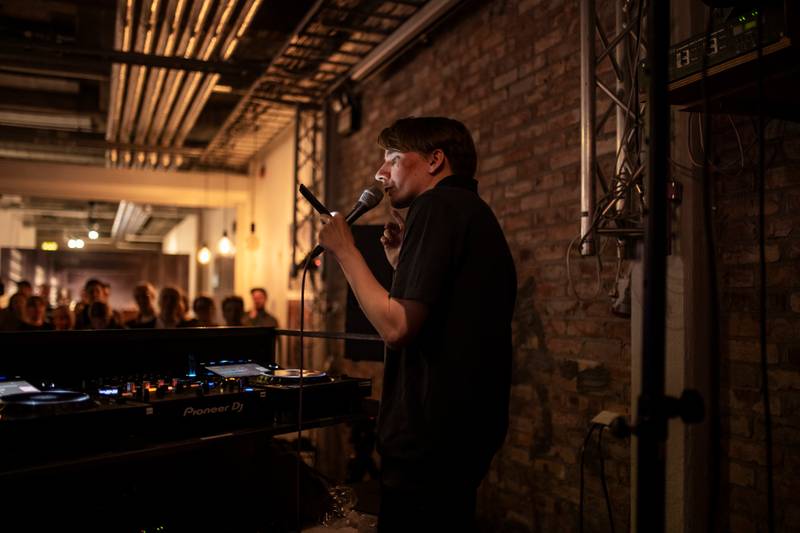

Ania Novak: To the Aching Parts! (Manifesto) Photographer: Ellika Henrikson
Niko Hallikainen: Mystery Machine (2022). Photographer: Ellika Henrikson
Theories of futures?
Theorist, curator and filmmaker Ariella Aïsha Azoulay, who has talked about co-citizenship, writes that unlearning insists that finding precedents ”for resistance to racial and colonial crimes is not the novel work of academic discovery.”6 There is a line in a poem by Sky Hopinka painted on the wall at Röda Sten that clarifies the point: “There are vast areas of human life to which scientific methodology is inapt.” forms of surrounding futures proposes that collective unlearning can start with artistic operations and not always, for example, academic and theoretical constructions, which are historically and in the present oppressive infrastructures of knowledge. The exhibition leans on the idea that the question of whether something needs, to follow Azoulay’s critique, to be discovered - that something new has to be created - is not essential.
Where propositions of futures and coexistence have been in the middle of theoretical debates in contemporary art and art history and theory for the past decade, this exhibition does not propose but rather presents; it does not, even though it states to, display forms of surrounding futures but rather forms a queer here-and-now; the future is there only to emphasise the potential of artistic, curatorial, and collective speculation. Where, for example, Göteborgs Posten’s critic Oscar Svanelid sees the exhibition as a port to another future7, for me the future—if it’s understood as a space for unlearning and transforming together—is already there in the exhibition. It seems to have moved on from something that feels stagnant. At times, the articulation of who has access to these spaces of speculation is not evident in the exhibition. Who has the opportunity to form coexistence and be included in the speculated future?
